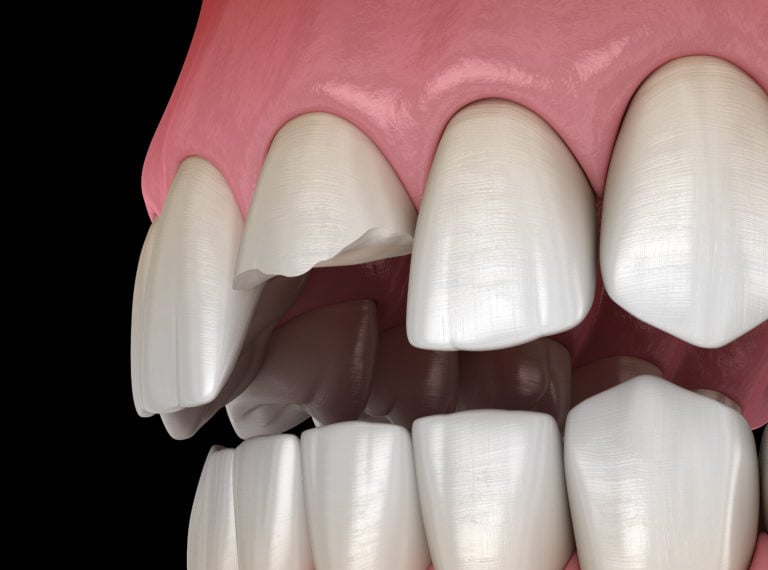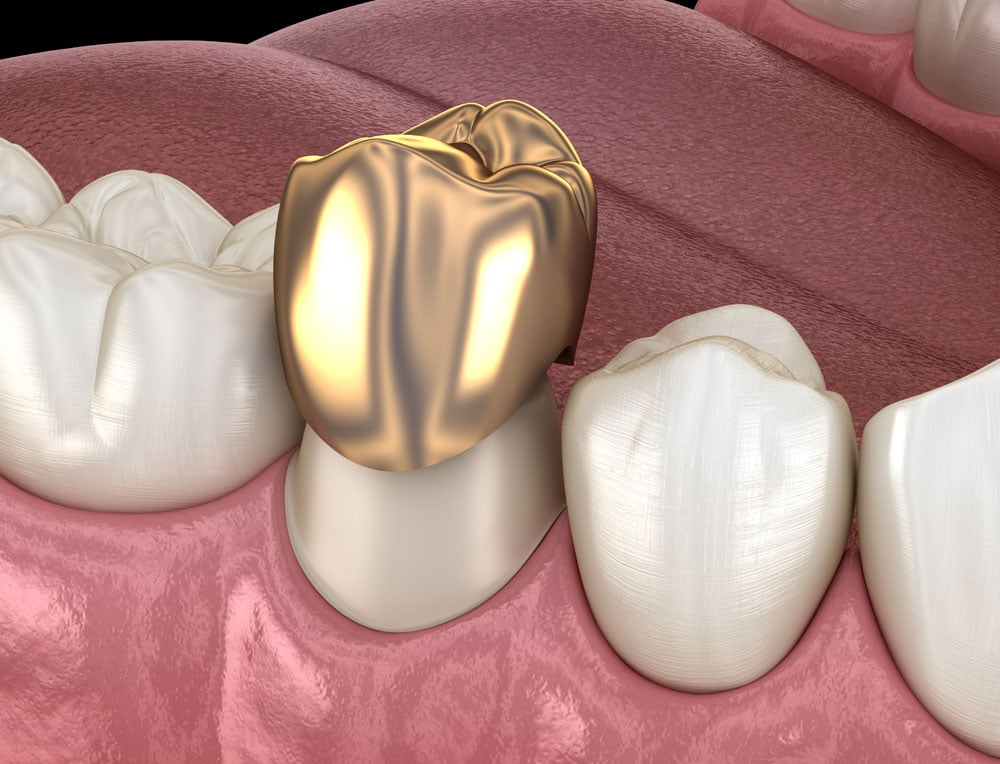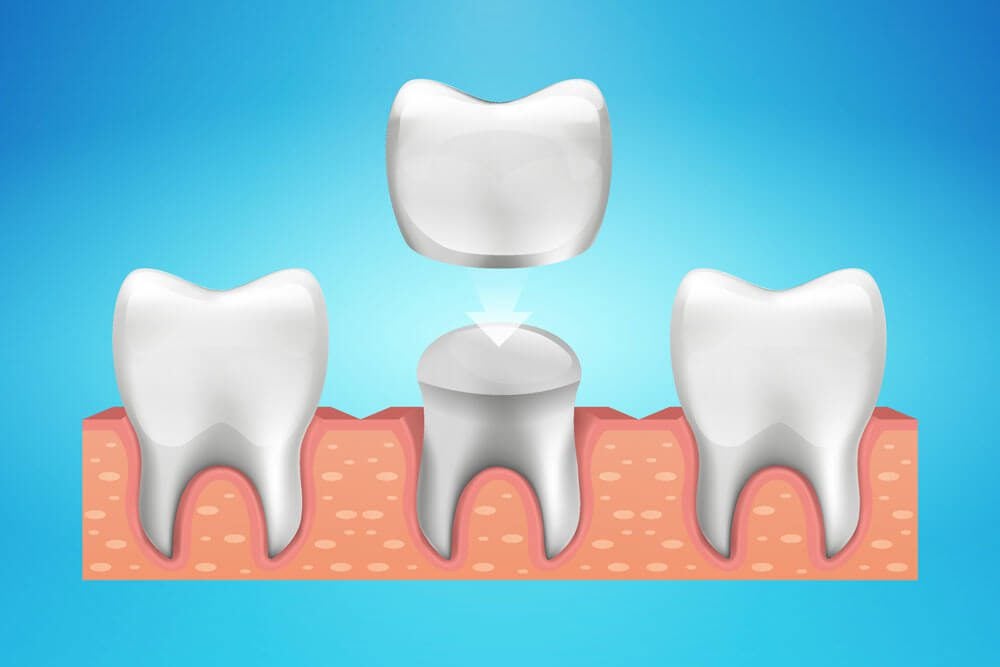Think you might need a dental crown (aka dental cap)? These restorations are extremely common and help so many people improve their smiles.
They serve to protect and strengthen weakened teeth while providing a beautiful esthetic solution.
I’m sure you’ve heard a lot about crowns but still have many questions about them.
What kind of crown should I get? Can I put a crown back on myself? Can a crown replace a missing tooth?
If you or your loved one needs a crown, read on. This article will answer all those questions for you.
What is a crown for your teeth?
A dental crown is like a cap covering a tooth due to decay, damage, or aesthetic issues.
There are various types of crowns based on material. The most popular are porcelain, gold, or a high-noble metal.
They are shaped to look like a natural tooth and fit over the tooth, protecting and strengthening it.
Most dental crowns cover the entire tooth, starting from the gum line. Other types may only cover a portion of the tooth.
Indications for needing a crown include:
-
- trauma that involves tooth fracture
-
- a root canal (a procedure where the nerves and infection inside a tooth are removed)
-
- a deep/large cavity
-
- a large filling that leaves behind little tooth structure remaining
-
- needing a bridge (where crowns are placed on the other teeth on either side of a missing tooth to connect a dental bridge).

The dental crown’s purpose is to protect the inner part of your tooth from further weakening or breakage.
It can significantly improve your ability to chew and eat by restoring broken or damaged teeth.
Crowns on baby teeth
Your child may need a crown on a baby tooth if:
-
- He or she has a cavity but is at high risk for tooth decay and has a hard time keeping up with good oral hygiene.
-
- He or she has a cavity that is too large to be filled. If a baby tooth is severely decayed, a crown can hold the tooth together until the adult tooth comes in.
Crown procedure
The procedure for a crown usually requires two visits.

The first visit
At your first visit, your dentist will use local anesthesia to numb the tooth that needs a crown. Then he or she will shave down your tooth so that the crown can fit properly. Afterward, they will take an impression or digital scan of the prepped tooth to send to the dental lab for fabrication.
You’ll get a temporary crown that day, which should last 2-3 weeks until the crown delivery appointment.
Once your dentist receives your crown from the dental lab, he or she will bring you in for your second visit. There, your new crown will be tried in, fitted, and placed.
This process may or may not require numbing. And you shouldn’t have pain. However, you may experience some post-operative tooth and gum sensitivity for several weeks in the area worked on.
Caring for crowns vs. caring for teeth
Teeth, unlike crowns, are made of living organic material. They:
-
- are constantly remineralizing and demineralizing throughout the day
-
- sightly wear down over time
-
- can be stained
-
- can be whitened
Dental crowns are inorganic, inanimate objects that cover the vulnerable living parts of the tooth. They may or may not wear over time – depending on the material.
Caring for your temporary crown
To make sure your temporary crown lasts until your next visit,
-
- chew on the opposite side of your mouth
-
- don’t eat sticky, chewy, or hard foods
-
- slide rather than lift floss from between the crowned tooth on either side (this might pull the crown off)
Care for your dental crown the same way you care for your teeth. The crown becomes part of your teeth’ structure.
Your crowns need regular brushing and flossing to maintain them for many years. And be mindful of your diet and lifestyle, which plays into how long your crowns last.
If you neglect your crowned teeth, they can become decayed (under or around the crown) further.
This is called “recurrent decay” and may require a replacement or more extensive dental treatment.
If you get recurrent decay under your crown, the crown will not stay on long. So take good of your crowns.
Crown faqs
What type of crown is best?
Type of crowns
There are three basic types of crowns:
-
- Metals: Gold is the ideal option, but some use other alloys
-
- Porcelain: An all-porcelain (ceramic) or porcelain-fused-to-metal crown is the best option for visible front teeth.
-
- Resin: a cheaper material that doesn’t last as long.

What is the best type of dental crown?
You will discuss with your dentist the best type of crown that suits your needs and aesthetic goals. This depends on how much of your tooth structure remains, the tooth’s location and function that will be crowned, the amount of gum that’ll show when you smile, and the color of the rest of your teeth.
Porcelain crowns
Porcelain is a great option for esthetics and durability. It isn’t a toxic material like mercury amalgam fillings.
It’s the ideal choice for front teeth because of their translucency and realistic appearance.
However, there are some disadvantages to porcelain crowns.
They don’t wear at the same rate as your teeth. So over time, the margin between the crown and the tooth can open up, letting in bacteria, leading to decay.
Also, a porcelain crown needs to be replaced every 15-20 years.
Metal Crowns
I don’t recommend base-metal material which is cheaper and lower in quality and doesn’t last very long.
And porcelain-fused-to-metal crowns may have a dark line around the gumline where the porcelain and metal meet. So this option isn’t ideal for front teeth as far as aesthetics is concerned.
Gold Crowns
Gold’s chemical make-up allows it to have the ideal fit, so the chances of bacteria getting in between the margin of the crown (which causes decay) are much less.
It also wears at virtually the same rate as our own teeth. That’s why gold crowns can last for almost a lifetime with proper care. They are ideal for less visible back teeth.
Zirconia crowns
Last but not least, zirconia crowns are my favorite type of crown. Zirconia crowns are categorized as ceramic crowns, but they are unique because they’re made of zirconium dioxide, a very durable type of metal related to titanium.

Because Zirconia is white, it’s a great cosmetic solution that can withstand the forces of bruxism (teeth grinding) and chewing for the long-term, unlike porcelain, which can chip from strong forces.
And due to its strength, it also allows your dentist to reduce less tooth structure when preparing your tooth for the crown.
Another advantage of zirconia is that it is biocompatible, which means it is less likely to provoke the body to react with an immunological response like inflammation.
However, there are some disadvantages to zirconia crowns. One, due to their hardness, there’s the potential of wear on the opposing enamel. Second, due to its slightly opaque appearance, it can sometimes be difficult to match a full-zirconia crown to your natural teeth. This isn’t an issue for the back teeth, which are less visible. A solution to this problem is layering zirconia with porcelain for a more translucent appearance.
How much does a crown cost?
A high-quality porcelain crown costs between $900-1600. A gold crown adds about $100 to the total cost. Zirconia crowns are typically more pricey than porcelain crowns, ranging from $1000 to-2000.
The price of a crown varies by location and provider. If you go to a specialist like a prosthodontist, the cost will be higher.
Although crowns can be expensive, it is worth it in the long run. Crowns are extremely important for your long-term dental health. If you need a crown, it’s crucial to get it as soon as possible. The longer you wait, the higher your risk for extensive complications and infection.
Also, it’s imperative to get a crown right after a root canal to prevent reinfection and damage in the future.
Can I just wear my temporary crown forever?
No, you should never just settle for a temporary crown. The type of materials used for temporary crowns eventually change in shape and wear down after a couple of weeks. This leads to the collection of bacteria, the shifting of other teeth, gum infection, and tooth decay.
Because a temporary crown is cemented with temporary cement, it doesn’t provide an adequate seal for long-term protection, leading to decay and future damage.
My crown fell off. Can I just glue it back on myself?
If your crown falls off, you want to see your dentist as soon as possible. In the meantime, a temporary solution is buying over-the-counter temporary dental cement to hold the crown for a few days until you see your dentist.
Do not use Super Glue to glue your crown back on. This is dangerous to your health and your tooth.
Depending on the condition of your tooth and crown, your dentist may or may not be able to cement the same crown back on. If there is decay or infection present or if the crown is defective, your dentist will provide treatment accordingly.
How does a crown stay on?
Did you know that your crown actually doesn’t stay on because of adhesion or cement? Dental crowns remain in place due to mechanical retention.
When your dentist prepares your tooth for the crown, the dental crown is made to be at a 3-degree angle or less to your tooth surface, creating parallel walls. So a crown with a large taper will not stay on.
Proper mechanical retention allows a crown to stay on for many years, as long as you practice good oral hygiene and take care of your crown.
The adhesive your dentist uses is luting cement, made from zinc oxide and eugenol. This material prevents saliva and bacteria from getting into the margin (the space between the tooth and the crown).
Why would my crown fall off?
A crown could come off if bacteria gets under the crown and causes decay. And if a crown starts to move, the cement will start crumbling, causing the crown to lose retention to the tooth.
How can I prevent my crown from falling off?
How you care for your crown and teeth will determine how long you keep your crown.
Follow the basic steps of good oral hygiene and a healthy lifestyle, including:
-
- Brushing and flossing properly
-
- Eating a healthy, clean diet (avoid processed foods)
-
- Avoiding sticky and hard foods
-
- Avoiding sugary and starchy foods
Can I whiten my crown?
No, crowns are not living teeth, so you can’t whiten them. They also cannot be stained like natural teeth.
If your teeth change color after getting a crown, you will need to get a new crown if you want to match the crown to your new tooth shade.
How long will my crown last?
If your crown is properly done, it should last anywhere from 10-20 years as long as you’re taking good care of it. A gold crown can last up to 30-50 years.
Over time, as your oral microbiome changes or teeth shift and wear, your crown may no longer fit well and need to be replaced.
Conclusion
Dental crowns are important for long-term dental health. They are used to restore damaged, decayed, or root-canal-treated teeth, providing strength and protection.
Crowns must be cared for like natural teeth to last you for years to come.
If your crown falls off, come in for an appointment right away. Do not use Super Glue or any other glues to put the crown back on yourself.
If you think you need a crown, come in today to restore your smile protect it for years to come.
Let us know if you have any other questions about dental crowns!
by Dr. Christine Coughlin DDS

Learn more:
How to get rid of a toothache at home



